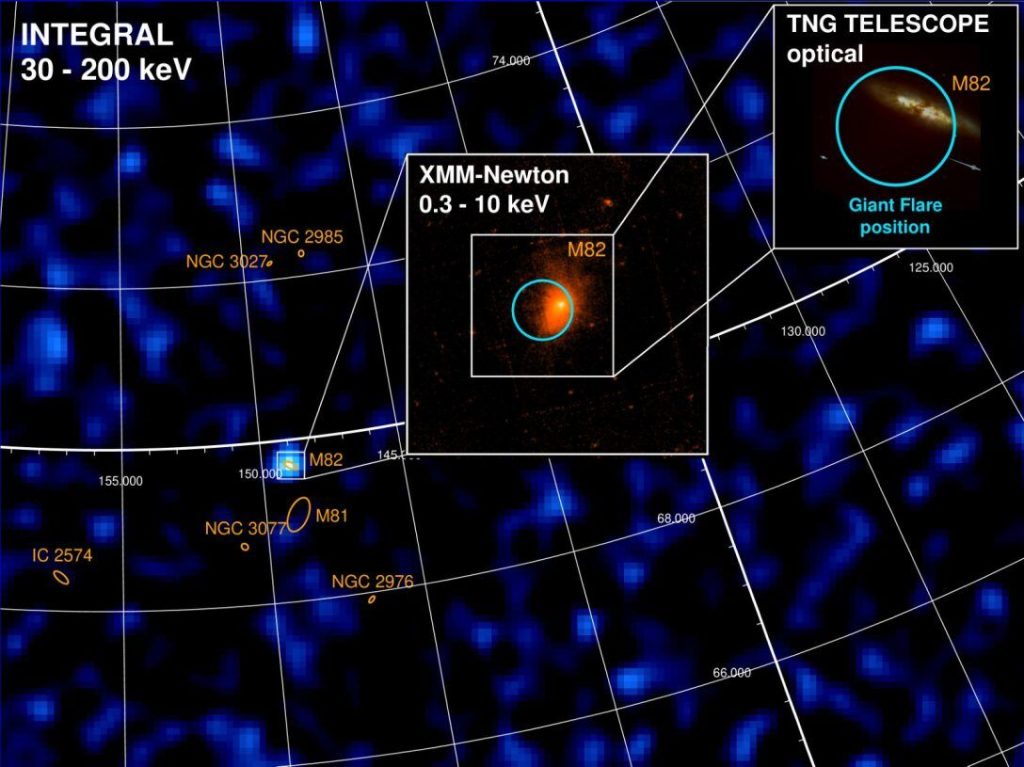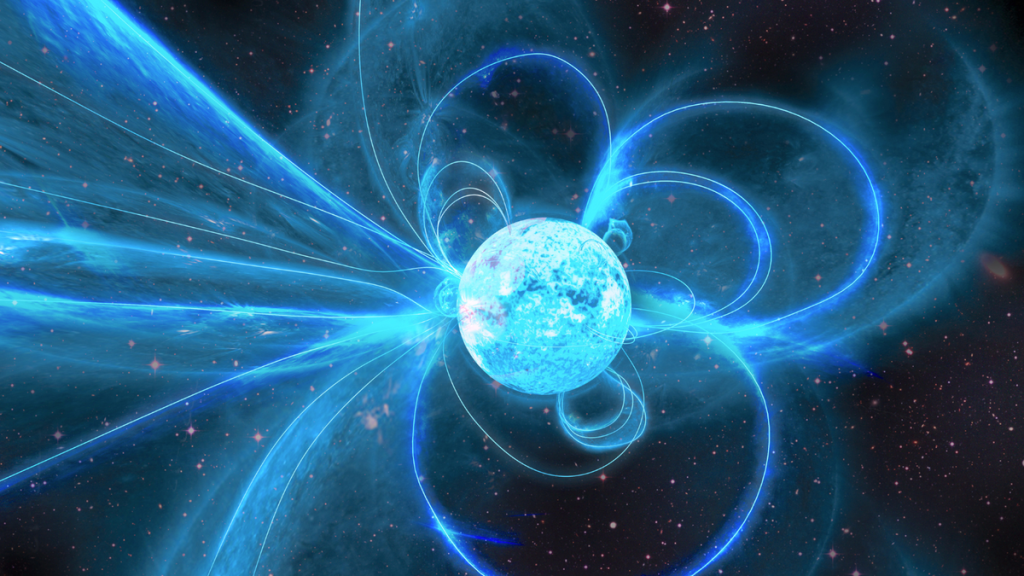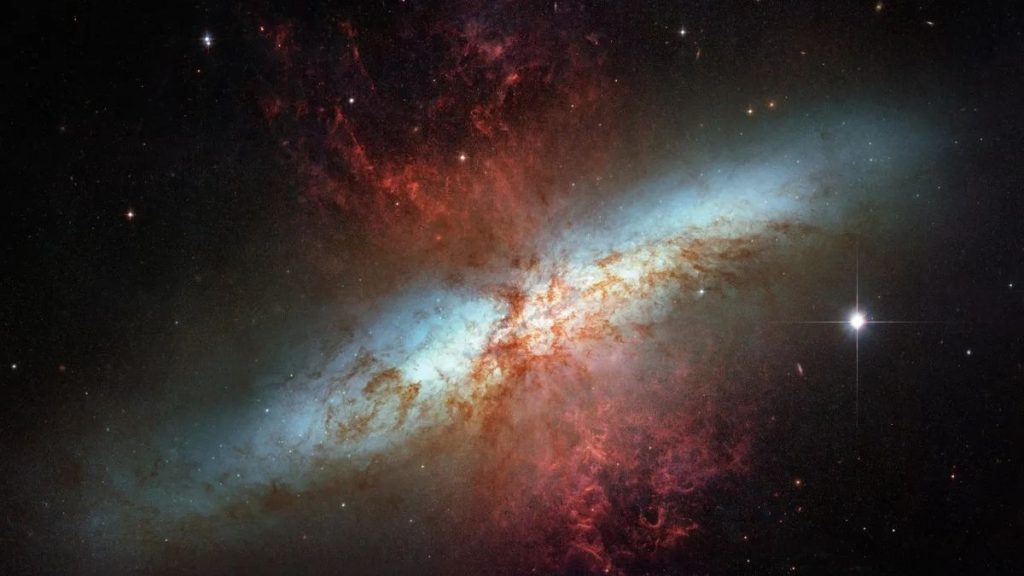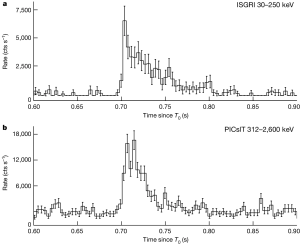A single transient event detected with INTEGRAL
The first extragalactic magnetar discovered by INTEGRAL! A unique transient event has been detected by the INTEGRAL satellite: until now, magnetars – neutron stars with hyper-strong magnetic fields – were known only in our galaxy. INTEGRAL, with the help of XMM and ground-based observatories, has discovered a magnetar in galaxy M82!
A look back at the detection of this “giant flare”, only the 4th in 50 years of observations! (article published in Nature)
While ESA’s INTEGRAL satellite was observing the Virgo galaxy cluster region in November 2023, the IBIS/ISGRI telescope suddenly detected a very brief gamma-ray signal, lasting only a tenth of a second (fugure opposite). Thanks to the INTEGRAL Burst Alert Sytem (IBAS), which analyzes ISGRI data in real time at the INTEGRAL Data Center (ISDC), an alert was issued just 13 seconds after the event, and on-call astronomers, including Diego Götz from DAp, quickly realized that this energetic event was associated with galaxy M82.
The question that then arose was: what was the nature of the object at the origin of the gamma-ray pulse? Was it a short gamma-ray burst (from the coalescence of two neutron stars) or a giant flare from a magnetar (neutron star with a very high magnetic field)?
The question that then arose was: what was the nature of the object causing the gamma-ray pulse? Was it a short gamma-ray burst (from the coalescence of two neutron stars) or a giant flare from a magnetar (neutron star with a very high magnetic field)?

The team in charge, which includes not only French researchers (DAp, LAM, LESIA, Observatoire de Paris), but also Italian, Swiss, Danish, German, Spanish and Irish scientists, requested that the region be observed by the ESA XMM telescope in X-rays, and by Telescopio Nazionale Galileo and Observatoire de Haute-Provence (by D. Turpin and E. Le Floc’h from DAp), in optics.
The absence of signals in the other electro-magnetic bands, as well as in gravitational waves (LIGO/VIRGO/KAGRA), ruled out the hypothesis of a short gamma-ray burst: in fact, short gamma-ray bursts are accompanied by afterglow emission detectable in X-rays and visible light, and the merger of two neutron stars in such a close galaxy (M82 is around 4 Mpc away) would have produced a gravitational-wave signal detectable by ground-based interferometers (as for GW 170817 located in a galaxy 40 Mpc away).
Composite image of observations by Integral, XMM-Newton and the Telescopio Nazionale Galileo TNG telescope.

Credit: ESA/Integral, ESA/XMM-Newton, INAF/TNG, M. Rigoselli (INAF)
INTEGRAL image of the Virgo cluster region at the time of the transient source detection. The small square on the Integral map indicates the location of the explosion. The blue circle on the two cut-out images indicates the error box estimated by IBAS. One image shows X-ray XMM data from the galaxy, the other a visible light observation. In both images (X-ray and visible), only the galaxy M82 is visible, with no other signal from the transient source.
So only the hypothesis of a giant flare produced by a magnetar was compatible with the observations.
Magnetars are neutron stars with a much higher magnetic field (up to 10,000 times) than standard pulsars, and are the product of supernovae from massive stars (at least eight times more massive than the Sun). They sporadically emit short gamma-ray bursts, and very rarely very energetic ones, known as giant flares.
Some thirty magnetars are known to exist in our galaxy and in the Magellanic Cloud. To date, only three giant flares have been detected in 50 years of observations.

M82 is a bright galaxy with a high star formation rate. It is therefore the site of the formation of massive stars that are expected to produce neutron stars at the end of their lives. The discovery of a magnetar in this type of galaxy confirms the hypothesis that magnetars are young objects and that we need to target this type of galaxy to continue detecting this type of object.
The event detected by INTEGRAL is the first magnetar discovered in a nearby galaxy, and will pave the way for the discovery of new extra-galactic magnetars by future missions dedicated to gamma-ray bursts, such as SVOM or THESEUS.
Contacts : Diego Gotz, Damien Turpin
Article:
A magnetar giant flare in the nearby starburst galaxy M82, Nature (2024). DOI: 10.1038/s41586-024-07285-4
https://www.nature.com/articles/s41586-024-07285-4



